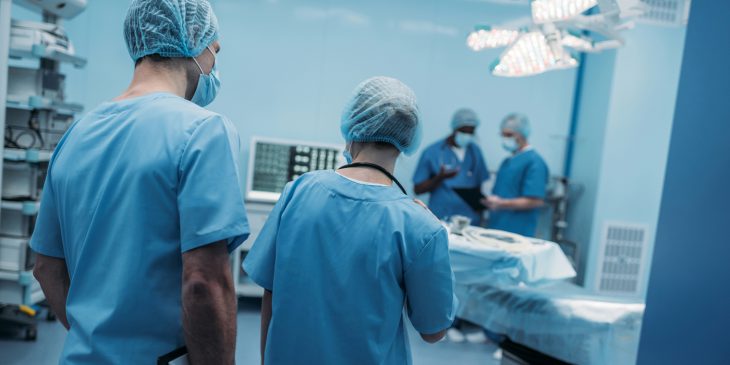My job at UPMC Enterprises – the innovation and commercialization arm of UPMC – is to observe health care professionals to determine how/if we can leverage information technology to improve patient care and outcomes. On Feb. 7, for the first time, I had the privilege of shadowing Dr. Sharon Goldstein, chief of general surgery at UPMC St. Margaret.
The morning of, I talked myself out of faking an illness and made it to the hospital. As I approached the operating room office, a very energetic woman asked if I was Stacy. I hesitated (this was my last chance to run), swallowed and confirmed that it was me. She pointed to the wooden doors. They opened. I entered.
On the other side, a woman greeted me with scrubs, quickly pointed me to a locker, handed me hair and shoe covers, pointed me to a place to change, and vanished. Standing in an OR locker room, I wondered “who was that blur of a person and where did these scrubs come from.”
 When my brain caught up to the present, I realized there were surgical professionals flying around me like they owned the place (go figure). Totally intimidated, I put my stuff in a locker and headed to the restroom to change. In the stall with nowhere to set the scrubs, I did the only thing I could – balled them up and tucked them under my chin. (No, it did not dawn on me to hang them over the door. I was nervous. Stop judging.) It was awkward and I almost fell in the toilet twice, but I successfully changed.
When my brain caught up to the present, I realized there were surgical professionals flying around me like they owned the place (go figure). Totally intimidated, I put my stuff in a locker and headed to the restroom to change. In the stall with nowhere to set the scrubs, I did the only thing I could – balled them up and tucked them under my chin. (No, it did not dawn on me to hang them over the door. I was nervous. Stop judging.) It was awkward and I almost fell in the toilet twice, but I successfully changed.
A tip for tying disposable scrub pants – if you pull one side of the tie too hard, the other side disappears in to the great beyond. Needless to say, I spent more time than I would like to admit recovering a lost tie.
Sporting my scrubs and hair and shoe covers, I made my way to the lounge to wait for the doctor while professionals buzzed around me, none of whom were yet sporting their hair and shoe covers. I convinced myself it was better to be ready than to cause delays. Dignity be damned!
When Dr. Goldstein came in, she was smiling like I was a long-lost friend. As she led me out to the patient waiting area, she asked if I had a doctorate and if she should introduce me as Dr. Norman. My professionalism defeated the adolescent voices in my head and we agreed she could introduce me as Stacy.
This is where “stuff” got real. The OR waiting area is much like a printer queue of surgical patients. Everybody is lined up waiting for their turn. You’re in a room with three walls and a thin curtain (designed by the same person who designs comforters for Days Inn), and you’re as nervous as a person can be. Your doctor enters and talks you through what’s about to happen. In your head, the doctor’s job is easy. You’re the one that’s being knocked out and cut open. Right?
That day, I saw the other side and had to remind myself to breathe. The patient knew I was there only to observe, yet still looked at me with nervous eyes. I watched Dr. Goldstein as she inspired confidence and made them feel safe enough to allow her to knock them out and cut them open. It’s a skill that is definitely taken for granted. When they looked at me, the need to do right by them overwhelmed me. The weight of that responsibility made me sick in the deepest pit of my gut and I wasn’t even going to be touching anybody!
I resisted the urge to hug the patient and left with the doctor. We made our way through the hospital to attend a meeting while we waited for the anesthesiologist to do her thing.
Please note two things – I was still sporting my hair and shoe covers for all the above, and if you don’t tie disposable scrub pants tightly enough, they will start to fall and you must figure out how to retie them while trying to keep up with the doctor’s quick pace while attempting to listen to every word.
After the meeting, we made our way back to the OR area and to that room we’ve all seen on TV where the surgeons scrub in. Dr. Goldstein handed me a mask that truly requires a doctorate to tie. I’m fairly certain she rolled her eyes at me as she turned and entered the OR with me tripping along behind her still tying my mask.
 There were six other people in the room who seemed to have expertly choreographed their dance. Everything and every person had a place, and were all adjusted to the doctor’s specifications. Suddenly, she asked for a pause and everybody stopped. She talked about who the patient was and why they were there. Each person then gave the equivalent of a NASA pre-launch status report and began.
There were six other people in the room who seemed to have expertly choreographed their dance. Everything and every person had a place, and were all adjusted to the doctor’s specifications. Suddenly, she asked for a pause and everybody stopped. She talked about who the patient was and why they were there. Each person then gave the equivalent of a NASA pre-launch status report and began.
Over the next hour, I watched them cut in to and remove an organ from a person. This wasn’t a movie or a video. They made small holes in his abdomen and literally inflated him. They put a camera inside his abdominal cavity, located his gallbladder, and painstakingly detached and pealed his gallbladder from his liver.
I know I said stuff got real before, but it got really real after Dr. Goldstein finished. A human gallbladder was placed on a tray in front of me. Literally, immediately in front of me and I had to look. It was surprisingly small and not gross. I questioned how something so small and benign-looking could cause that much trouble.
At that moment, I was proud of myself and decided that my gross threshold warrants a mental happy dance. Just when I start busting a move, the doctor says, “Stacy, put gloves on.” My brain made that record stop/scratch noise. Why would I need gloves?
I was informed that we were going to open the gallbladder, and suddenly my happy dance was replaced by a very confused cartoon version of me repeatedly asking “what’s happening,” as well as a 10-year-old boy version of me running around yelling, “This is too cool!”
All gloved up, I was instructed to squeeze the gallbladder. I felt an ungodly large and hard something inside this tiny organ and shared an impromptu expletive. I was then taught how to open a gallbladder and recover a stone.
All of the above coolness aside, the most striking experience of the day was getting to know Dr. Goldstein. She’s an incredible human. Kind. Compassionate. Empathetic. A loving parent and daughter, and an absolute bad ass in the OR. All day, she handled high-pressure and highly emotional situations with grace. At the very end of the day, I learned that she had witnessed the passing of a friend just the night before, which exponentially amplified my respect for her.
Truly, my vocabulary is not such that I can do justice to this experience and my admiration of all of the folks involved. All I can say is that I have a new respect for human resilience, kindness and comradery.
Stacy Norman is a product manager at UPMC Enterprises









